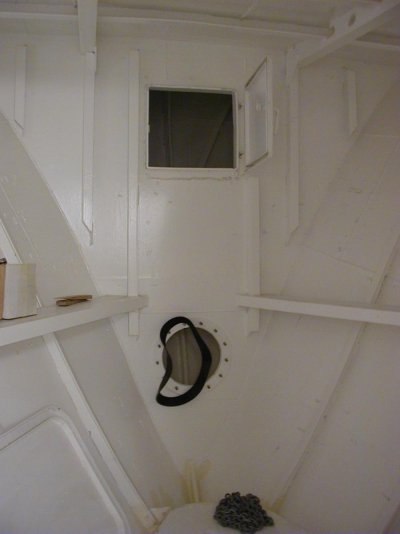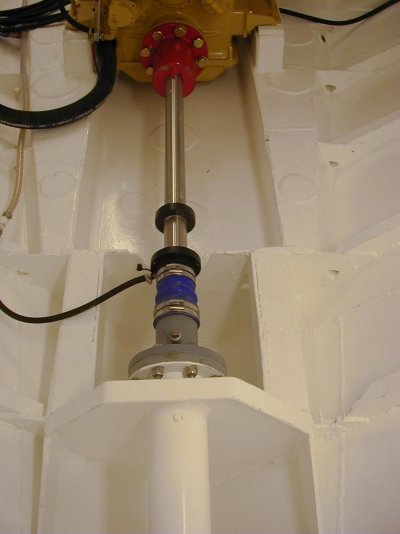When George Buehler designed the "original" Diesel Duck (not SHM's new and greatly improved version) there was no sugar scoop stern on them and, I'm assuming here, there was no stern fuel tank acting as a watertight crash bulkhead.
I don't think the stern fuel tank showed up until later in the DD 462 line. The DD that was the base for the 462 just had the stern plating as best I can tell which is certainly strong enough.
So, what I'm getting at here is that, although splitting the stern fuel tank on a SHM version of the DD removes one of the five watertight bulkheads, is it really "unsafe"? Me thinks not. How many oceangoing trawlers out there have a watertight bulkhead at the stern? Me thinks very few. Nordhavn's definitely don't have one and they're considered very safe bluewater passagemakers.
SHM's design, minus the stern thruster is safer but I certainly would not argue it is unsafe, just less safe.

It is just one of those things the owner needs to prioritize. Flip side is that a good part of the stern is still double hulled as one can see in the photo. Only a small part is no longer double hulled. From a safety perspective, the differences is pretty close to zero that is for sure. What does bother me about the stern thruster is it hanging off the stern in a stern tie situation. I think that is the more likely vulnerability compared with someone running another boat into the stern of the DD and poking a hole into the hull.
I do think it would be very nice to have a stern thruster and the overall usefulness of the stern thruster is a worthwhile compromise. Having said that, I do wonder if the articulated rudder would provide most of the usefulness of the stern thruster with none of the thruster's build compromises?
So it's my opinion that Mr. Bill Kimley is simply not happy about some of us messin' with his new and improved version of George Buehler's Diesel Duck and Bill has every right to voice his objections but when it comes down to it we, as buyers, should be able to have changes made as long as they don't compromise the structural integrity or overall safety of the vessel. Just Sayin'
As someone who has designed stuff for many years and whose job responsibilities involve criticizing other people's designs and then breaking those designs and implementations, I have noticed it can be hard to not take comments/changes about a design personally. George seems to argue over design changes to a point but I think he does see the value in other people's updates and how they have improved the DD's over the years. Certainly, Bill's changes have greatly improved the DDs and I think George openly admits that others have improved his designs over the years. Bill's swim step and side galley passage is a really great design idea.
I would guess people looking at the 462/492 designs are really only talking about changing maybe 5% of the design? We are not even at the 90/10 rule, meaning 90% of the work goes into the last 10%. I think we are more like 95/5.

I have spent hours looking at the various DD deck plans, especially the 462/492 layout, and when I think maybe I have found a better idea, usually I am wrong.


The current design is the best possible layout when you start realizing the implications of design changes. Now, I do see where some slight changes to the PH and forward stateroom would better meet OUR needs but they are really nits. Ok the PH changes might not be a nit but we are the only people who want a copilot seat.

The Customer should get what they want, within reason.

One problem with design, or material changes, is that if the production team is used to doing things a certain way, changing the process can cause problems. The employees get efficient at doing things a certain way, with certain materials, and a change can cost them time and decrease their quality of installation.
When I was designing our house, I ***REALLY *** wanted to use ICF(Insulated Concrete Forms) because they build a really tight, energy efficient and STRONG house. After talking to a number of builders, some of whom I would not let build a dog house, we found a builder who was a PE, had decades of building experience, we got along with him very well, he was trustworthy and honest....
But he had never worked with ICF's before but he was willing to try.

Course, not many builders had or have used ICF's and getting the right builder was far more important than using a given house material. I had read up on ICF 10-20 years and letting go of the idea of using ICFs was not easy but after looking at my design that poked quite a huge holes in the ICF walls for large windows and doors it seemed a bit silly to continue with ICFs. It was also far more important to have the right builder vs the "right" material. We wanted a builder who would build the best house irregardless of the material. There is more than one way to skin a cat, so to speak.

We made the right decision. Our builder and his family became friends. Not many people can say that about their house builder.

We had some issues with the build but nothing is perfect, and to be honest, very few people would noticed the nits that piss me off.



It pisses me off because I know how *** I *** wanted things done and a certain contractor did not do it right and by the time I and the builder caught the issue it was too late to change. We are talking about something happening in a day or two and it is about the way the HVAC was installed in the attic. To be fair it really is a Who Gives a Sh...t but it still pisses me off.

Later,
Dan




 It is one of the things I really wanted to photograph.
It is one of the things I really wanted to photograph. 




 Bill is right about the compromises needed to add the stern thruster and it really gets down to what the owner thinks is most important. Bill will give you his opinion and build what the Customer wants if the request is reasonable/doable.
Bill is right about the compromises needed to add the stern thruster and it really gets down to what the owner thinks is most important. Bill will give you his opinion and build what the Customer wants if the request is reasonable/doable.